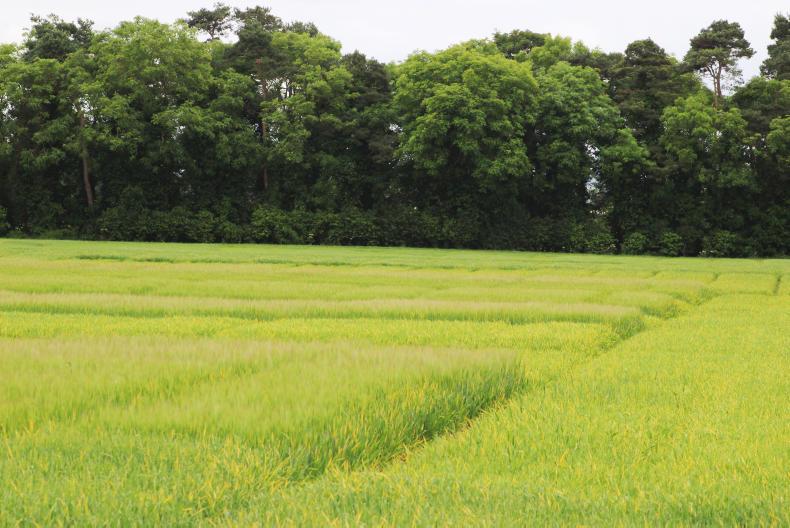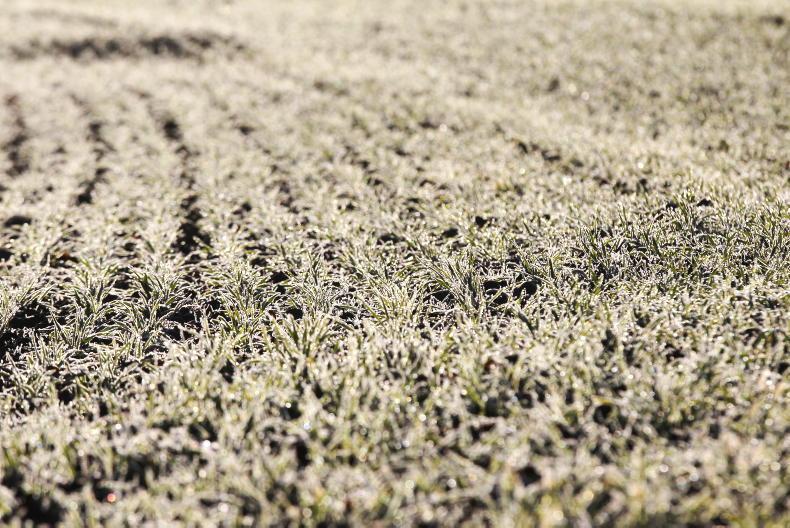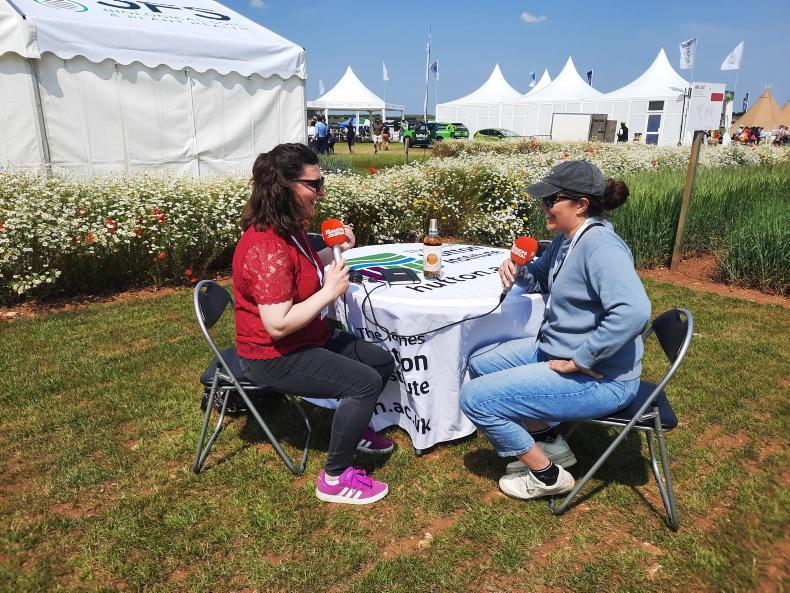Tillage farmers must avail of the opportunity to attend Crops & Spreaders next week for two very good reasons. Firstly, if you feel that your industry is important and relevant to modern farming in Ireland, it is important to make that statement through the numbers attending. Secondly, there is a huge amount of research on show, all of which is relevant and much of which is critical to new decisions that you will have to make on alternative control practices in the near future.
The special supplement for the event in this week’s Irish Farmers Journal lists the many stations for the open day which offer a mix of research and advice on a range of crops and topics. While all topics are highly relevant to crop producers, some will have a greater interest in some areas than others, so it is important to plan your route through the event. Last week, I took a run through some of the research and this article suggests the more visual observations that are well worth seeing.
BYDV
For the past nine months, much of the conversation at every tillage event has hinged around the loss of Redigo Deter and our ability to control barley yellow dwarf virus in autumn and spring. Most will know that Louise McNamara has been doing a lot of research on this topic and there are now a lot of BYDV control trials in the ground.
Previous research at Oak Park advised the application of two aphicides to early-sown winter crops and one to crops sown in the second half of October. For spring crops sown after early April the advice has been to apply one aphicide at the four- to five-leaf stage. This advice too is being re-checked.

Ramularia infection on a winter barley leaf showing the rectangular lesions with yellow ends.
BYDV pressure is relatively high at Oak Park and the effect of planting date is obvious in the spring-sown plots in the many different trial locations. It is important for growers to realise the impact that sowing date has on pressure and that every insecticide used can reduce the efficacy of a following application. So it is important to know how best to use insecticides.
Varieties
All of the varieties being tested in the recommended list are grown at Oak Park, both with and without plant protection products. Growers can see first-hand the relative strengths and weaknesses on individual varieties.
As we all know, this is a very different year that has brought different disease problems and pressures. While mildew was a problem on many crops throughout the winter, the only winter barley disease worth talking about now is ramularia. It is strong and aggressive on winter barley plots where it was not controlled. And control is an increasing challenge given that chlorothalonil (CTL) will be lost to us from next May and it is the only very effective active that we have currently.
That said, it appears that all of the new actives coming through from new families are currently showing good activity against this disease. It is obvious from these trials that folpet is not as effective as CTL applied as a single dose late in barley. However, it seems that a double application of a somewhat reduced rate has provided very good performance. It would also seem that a triple application of prothioconazole has been surprisingly effective but that cannot be regarded as a control measure because of implications for other diseases.
While there is certainly septoria on winter wheat, it has not been the dominant disease so far. That is likely to change by next week given the recent heavy rain. Yellow rust has been the most visible disease to date, with Garrus obviously the worst affected. Bennington also showed a lot of infection early on, but the disease did not seem to be as bad on the upper leaves. JB Diego showed significant infection on the whole plant but not nearly as bad as Garrus.

Severe yellow rust on untreated Garrus winter wheat at Oak Park last week.
Last week, BYDV was the most obvious disease symptom in the spring barley varieties (though not very bad) but there was a little rhyncho and net blotch present also.
Oats
Most oat growers will be aware of the huge amount of exploratory research being done on oats at Oak Park. This work is continuing to explore the basis of yield formation in oats, both winter and spring. This is helping to identify optimum rates and timings for inputs such as seeding rates, nitrogen and growth regulation and the sensitivity of the crop to weather.
The simple untangling of the dominant components of yield is critical information for growers. We know that in barley the delivery of high yield is dependent on having adequate ears per unit area while wheat is much more flexible on ear count as a plant can carry a huge number of grains to help compensate for something else until quite late in the season.
We now know that oats is somewhat similar to wheat and that plants in a low-density situation can carry up to 200 grains per panicle (ear of oats) and that this number falls as the number of fertile stems increases. While we may have known this from experience, having the numbers derived from research adds greatly to the ability of growers and advisers to make better informed decisions.
The research on show this year is mainly on spring oats which is a very important crop for some growers and for all who have been driven away from the winter crop by the presence of oat mosaic virus in some fields or farms. This is a virus disease spread by a soil-borne fungus which remains in the soil for quite a long time.
Crop margins
Many growers around the country have been plagued by invading grasses around headlands, whether from hedges or open spaces. Perhaps the worst offenders in this regard has been the bromes, which seem to have availed of the lack of competition in patches and strips where other vegetation was killed by glyphosate. And from these strips the weed has continued to fall out into the crop and be taken further in-field by combines.
While there are occasional problems across full fields, bromes tend to be worst along edges where burial is incomplete. A few years ago, when compulsory buffer strips were imposed along watercourses some growers left these buffer areas idle and the weeds proliferated further.
Work at Oak Park has shown that where these areas were sown to other plant mixtures the weed grasses have virtually disappeared.
The Oak Park work shows a range of different sown species versus the crop itself and that conversation is worth having if you have these problems in your fields.
It is also known that this same area close to the hedges (2m to 3m) is poorly productive due to falling fertility and lime status in this strip for many years. So putting it down to a mixture that would suppress weeds could have little or no consequence for field yield but profitability could benefit from either direct or indirect income derived as an environmental measure. Such an action does not have to be permanent.
An important lifeline in cereal production is the ongoing availability of new proven commercial varieties. More and more, we need those varieties to have natural traits such as better disease resistance, adequate or superior quality, tolerance to BYDV, good nutrient use efficiency, etc. Breeding continues to try and deliver these traits and work at Oak Park aims to help the process for plant breeders. Visitors may see plots of very different and even unusual looking crop varieties which are part of a project to look for traits in breeding material that could help to deliver the traits we need in Ireland.
Being able to identify weeds and grass weeds is an increasing requirement of modern farming. It is increasingly critical that a grower is able to identify a single plant when it occurs rather than waiting for a problem to develop before recognising the menace that some of these weeds present. One stand will have a workshop to help growers recognise and identify these problem weeds.
Many stands will talk about integrated pest management and biodiversity, topics that have become increasingly important, not just because they are populous terms but rather because we will depend more on these to help control current problems in the future as we lose more and more of our chemicals.
Many other crops will also be under the spotlight with a lot of work taking place on beans and oilseed rape, with rye and forestry also featuring. There is also information on climate change issues, health and safety, soil health and fertility, fertiliser issues and many other topics.
This is going to be a busy day and a busy event so growers should plan their route to maximise the information that can be accessed on the day. The event will also have a fertiliser spreader demonstration area plus crops growing on treatments that involve organic manures. This area, in front of the entrance to the main house, will have trade stands, as well as options for food, etc.
Tillage farmers must avail of the opportunity to attend Crops & Spreaders next week for two very good reasons. Firstly, if you feel that your industry is important and relevant to modern farming in Ireland, it is important to make that statement through the numbers attending. Secondly, there is a huge amount of research on show, all of which is relevant and much of which is critical to new decisions that you will have to make on alternative control practices in the near future.
The special supplement for the event in this week’s Irish Farmers Journal lists the many stations for the open day which offer a mix of research and advice on a range of crops and topics. While all topics are highly relevant to crop producers, some will have a greater interest in some areas than others, so it is important to plan your route through the event. Last week, I took a run through some of the research and this article suggests the more visual observations that are well worth seeing.
BYDV
For the past nine months, much of the conversation at every tillage event has hinged around the loss of Redigo Deter and our ability to control barley yellow dwarf virus in autumn and spring. Most will know that Louise McNamara has been doing a lot of research on this topic and there are now a lot of BYDV control trials in the ground.
Previous research at Oak Park advised the application of two aphicides to early-sown winter crops and one to crops sown in the second half of October. For spring crops sown after early April the advice has been to apply one aphicide at the four- to five-leaf stage. This advice too is being re-checked.

Ramularia infection on a winter barley leaf showing the rectangular lesions with yellow ends.
BYDV pressure is relatively high at Oak Park and the effect of planting date is obvious in the spring-sown plots in the many different trial locations. It is important for growers to realise the impact that sowing date has on pressure and that every insecticide used can reduce the efficacy of a following application. So it is important to know how best to use insecticides.
Varieties
All of the varieties being tested in the recommended list are grown at Oak Park, both with and without plant protection products. Growers can see first-hand the relative strengths and weaknesses on individual varieties.
As we all know, this is a very different year that has brought different disease problems and pressures. While mildew was a problem on many crops throughout the winter, the only winter barley disease worth talking about now is ramularia. It is strong and aggressive on winter barley plots where it was not controlled. And control is an increasing challenge given that chlorothalonil (CTL) will be lost to us from next May and it is the only very effective active that we have currently.
That said, it appears that all of the new actives coming through from new families are currently showing good activity against this disease. It is obvious from these trials that folpet is not as effective as CTL applied as a single dose late in barley. However, it seems that a double application of a somewhat reduced rate has provided very good performance. It would also seem that a triple application of prothioconazole has been surprisingly effective but that cannot be regarded as a control measure because of implications for other diseases.
While there is certainly septoria on winter wheat, it has not been the dominant disease so far. That is likely to change by next week given the recent heavy rain. Yellow rust has been the most visible disease to date, with Garrus obviously the worst affected. Bennington also showed a lot of infection early on, but the disease did not seem to be as bad on the upper leaves. JB Diego showed significant infection on the whole plant but not nearly as bad as Garrus.

Severe yellow rust on untreated Garrus winter wheat at Oak Park last week.
Last week, BYDV was the most obvious disease symptom in the spring barley varieties (though not very bad) but there was a little rhyncho and net blotch present also.
Oats
Most oat growers will be aware of the huge amount of exploratory research being done on oats at Oak Park. This work is continuing to explore the basis of yield formation in oats, both winter and spring. This is helping to identify optimum rates and timings for inputs such as seeding rates, nitrogen and growth regulation and the sensitivity of the crop to weather.
The simple untangling of the dominant components of yield is critical information for growers. We know that in barley the delivery of high yield is dependent on having adequate ears per unit area while wheat is much more flexible on ear count as a plant can carry a huge number of grains to help compensate for something else until quite late in the season.
We now know that oats is somewhat similar to wheat and that plants in a low-density situation can carry up to 200 grains per panicle (ear of oats) and that this number falls as the number of fertile stems increases. While we may have known this from experience, having the numbers derived from research adds greatly to the ability of growers and advisers to make better informed decisions.
The research on show this year is mainly on spring oats which is a very important crop for some growers and for all who have been driven away from the winter crop by the presence of oat mosaic virus in some fields or farms. This is a virus disease spread by a soil-borne fungus which remains in the soil for quite a long time.
Crop margins
Many growers around the country have been plagued by invading grasses around headlands, whether from hedges or open spaces. Perhaps the worst offenders in this regard has been the bromes, which seem to have availed of the lack of competition in patches and strips where other vegetation was killed by glyphosate. And from these strips the weed has continued to fall out into the crop and be taken further in-field by combines.
While there are occasional problems across full fields, bromes tend to be worst along edges where burial is incomplete. A few years ago, when compulsory buffer strips were imposed along watercourses some growers left these buffer areas idle and the weeds proliferated further.
Work at Oak Park has shown that where these areas were sown to other plant mixtures the weed grasses have virtually disappeared.
The Oak Park work shows a range of different sown species versus the crop itself and that conversation is worth having if you have these problems in your fields.
It is also known that this same area close to the hedges (2m to 3m) is poorly productive due to falling fertility and lime status in this strip for many years. So putting it down to a mixture that would suppress weeds could have little or no consequence for field yield but profitability could benefit from either direct or indirect income derived as an environmental measure. Such an action does not have to be permanent.
An important lifeline in cereal production is the ongoing availability of new proven commercial varieties. More and more, we need those varieties to have natural traits such as better disease resistance, adequate or superior quality, tolerance to BYDV, good nutrient use efficiency, etc. Breeding continues to try and deliver these traits and work at Oak Park aims to help the process for plant breeders. Visitors may see plots of very different and even unusual looking crop varieties which are part of a project to look for traits in breeding material that could help to deliver the traits we need in Ireland.
Being able to identify weeds and grass weeds is an increasing requirement of modern farming. It is increasingly critical that a grower is able to identify a single plant when it occurs rather than waiting for a problem to develop before recognising the menace that some of these weeds present. One stand will have a workshop to help growers recognise and identify these problem weeds.
Many stands will talk about integrated pest management and biodiversity, topics that have become increasingly important, not just because they are populous terms but rather because we will depend more on these to help control current problems in the future as we lose more and more of our chemicals.
Many other crops will also be under the spotlight with a lot of work taking place on beans and oilseed rape, with rye and forestry also featuring. There is also information on climate change issues, health and safety, soil health and fertility, fertiliser issues and many other topics.
This is going to be a busy day and a busy event so growers should plan their route to maximise the information that can be accessed on the day. The event will also have a fertiliser spreader demonstration area plus crops growing on treatments that involve organic manures. This area, in front of the entrance to the main house, will have trade stands, as well as options for food, etc.












SHARING OPTIONS